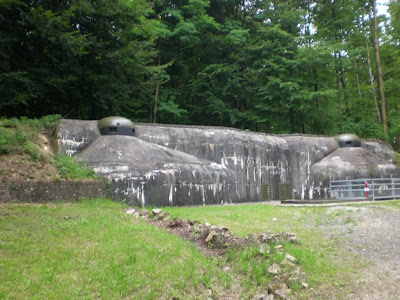 I'm sure the village has rules written or unwritten as to what color a house can be painted as no two houses next to each other are painted the same.
I'm sure the village has rules written or unwritten as to what color a house can be painted as no two houses next to each other are painted the same. 
 No problem here with grafitti or litter on the streets.
No problem here with grafitti or litter on the streets. Betcha people don't have to lock their doors.
Betcha people don't have to lock their doors. Note the window sills with flowers.
Note the window sills with flowers. So, leaving this beautiful village surrounded by farmland I stop to check out a clump of trees near the side of the road as they just look out of place.
So, leaving this beautiful village surrounded by farmland I stop to check out a clump of trees near the side of the road as they just look out of place.
Closer inspection finds World War II pillbox.
 I'm sure the locals wish they could do away with reminders like this but unfortunately these concrete slabs can't be bulldozed or easily taken apart.
I'm sure the locals wish they could do away with reminders like this but unfortunately these concrete slabs can't be bulldozed or easily taken apart.
I'm on a backroad making my way back to the German border (about six miles) and amazingly I keep coming upon more World War II sites.
 This above ground concrete fortification is called a casemate. You get close-up and can see large chunks of concrete missing. War details: the Americans attacked this casement and the Germans retreated. The Americans took over, were attacked by the Germans with the Americans having to retreat. The Americans attacked again (with air support) and finally secured the premises.
This above ground concrete fortification is called a casemate. You get close-up and can see large chunks of concrete missing. War details: the Americans attacked this casement and the Germans retreated. The Americans took over, were attacked by the Germans with the Americans having to retreat. The Americans attacked again (with air support) and finally secured the premises.  Only a mile from the casemate I come upon a privately-run World War II museum. It's a fascinating visit because scattered about the grounds are all kinds of military vehicles and equipment used during the war including amphibious transporters, jets, tanks, artillery pieces and so on.
Only a mile from the casemate I come upon a privately-run World War II museum. It's a fascinating visit because scattered about the grounds are all kinds of military vehicles and equipment used during the war including amphibious transporters, jets, tanks, artillery pieces and so on.  Vivid displays in this underground bunker shows photos of what happened in this area during the war. The nearby town was leveled with the Americans and Germans battling house to house (with tanks) while locals huddled in their basements. The death toll for civilians was very high. The Americans captured the town, the Germans counterattacked and took it back, then the Americans attacked again and held the town or what was left of it.
Vivid displays in this underground bunker shows photos of what happened in this area during the war. The nearby town was leveled with the Americans and Germans battling house to house (with tanks) while locals huddled in their basements. The death toll for civilians was very high. The Americans captured the town, the Germans counterattacked and took it back, then the Americans attacked again and held the town or what was left of it.  It's a fascinating and at the same time sad place to visit.
It's a fascinating and at the same time sad place to visit.






























 Major disappointment as medieval fortifications were now where to be found! These two photos are of the main square. Lots of beautiful turn-of-the-century buildings in town as many prosperous wine merchants lived here.
Major disappointment as medieval fortifications were now where to be found! These two photos are of the main square. Lots of beautiful turn-of-the-century buildings in town as many prosperous wine merchants lived here.













